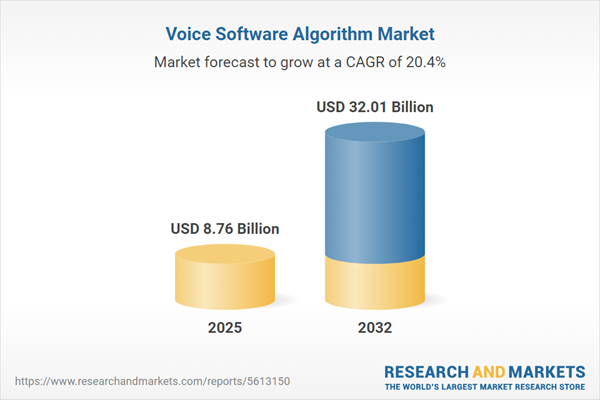Speak directly to the analyst to clarify any post sales queries you may have.
The Voice Software Algorithm Market is entering a pivotal phase as enterprises intensify their focus on automation, customer experience, and operational efficiency. Senior leaders evaluating technology investments must understand the sector’s evolution, deployment decisions, and regulatory crosswinds to shape future-ready strategies.
Market Snapshot: Voice Software Algorithm Market Size and Growth
The Voice Software Algorithm Market grew from USD 7.26 billion in 2024 to USD 8.76 billion in 2025. It is expected to continue growing at a CAGR of 20.37%, reaching USD 32.01 billion by 2032. Market expansion is driven by increased adoption of advanced speech interfaces, improved natural language understanding, and integration of voice solutions into enterprise workflows. Organizations are prioritizing technologies that facilitate seamless, omnichannel customer engagement and leverage contextual language models for richer, more adaptable voice interactions across touchpoints.
Scope & Segmentation
This research comprehensively analyzes deployment models, service options, geographic penetration, and leading vendors across the industry.
- Deployment Mode: Cloud (encompassing private cloud, public cloud, multi tenant, single tenant) and On Premise (comprising hosted and internal solutions). Each mode offers unique implications for data governance, latency, and operational integration.
- Services: Integration (consulting and implementation), and Support and Maintenance. These address strategic planning, custom system integration, and long-term operational excellence.
- Regional Coverage: Americas (North America—including United States, Canada, Mexico, and Latin America—including Brazil, Argentina, Chile, Colombia, Peru), Europe, Middle East & Africa (including United Kingdom, Germany, France, Russia, Italy, Spain, Netherlands, Sweden, Poland, Switzerland, United Arab Emirates, Saudi Arabia, Qatar, Turkey, Israel, South Africa, Nigeria, Egypt, Kenya), Asia-Pacific (China, India, Japan, Australia, South Korea, Indonesia, Thailand, Malaysia, Singapore, Taiwan).
- Key Vendors: Amazon.com, Inc., Google LLC, Microsoft Corporation, International Business Machines Corporation, iFLYTEK Co., Ltd., H2O.ai, Inc., Apple Inc., DataRobot, Inc., SoundHound AI, Inc., IT Chronicles Media Inc.
Key Takeaways for Senior Decision-Makers
- Enterprises see increasing operational value by embedding voice algorithms into core processes instead of treating voice features as stand-alone.
- Regulatory expectations, such as privacy and data consent, define architecture and vendor choices—requiring close collaboration across compliance, procurement, and technology teams.
- Segmented adoption patterns emerge between on-premise and cloud deployments, influencing integration timelines and total cost of ownership.
- Talent strategies must focus on cross-disciplinary expertise uniting machine learning, speech science, and systems integration to streamline pilot-to-production transitions.
- Vendor selection is shaped by capabilities in integration, explainability, and flexible contracting models, especially under shifting trade and tariff policies.
- Regional dynamics—such as linguistic diversity in EMEA and mobile-first behaviors in Asia-Pacific—drive the need for localization and tailored deployment strategies.
Tariff Impact on Voice Software Algorithms
Recent U.S. tariff policy changes are altering sourcing, procurement, and vendor engagement for organizations deploying voice software algorithms. Companies are diversifying supplier bases and reevaluating landed costs to maintain margin stability. Modular architectures and software-centric workflows are being favored to minimize tariff exposure and supply chain disruptions. Enhanced supply chain transparency and risk-sharing in contracts have become critical for sustaining project momentum.
Methodology & Data Sources
Findings are derived from structured interviews with industry practitioners, technical leads, and procurement specialists. These qualitative insights are cross-referenced with secondary research, including vendor documentation and technical literature. Methodological rigor is maintained through scenario analysis and expert review to ensure the results are actionable and relevant.
Why This Report Matters
- Enables technology and product leaders to make informed investment and integration decisions for scalable, compliant voice solutions.
- Offers targeted guidance to procurement and legal stakeholders for managing supply chain, regulatory, and contractual complexity.
- Supports executive teams in identifying vendors, partnership models, and internal capability gaps critical for long-term adoption success.
Conclusion
The Voice Software Algorithm Market presents both growth opportunities and operational challenges. Aligning technical, governance, and procurement strategies positions enterprises to maximize value as they scale voice-driven capabilities across business functions.
Additional Product Information:
- Purchase of this report includes 1 year online access with quarterly updates.
- This report can be updated on request. Please contact our Customer Experience team using the Ask a Question widget on our website.
Table of Contents
3. Executive Summary
4. Market Overview
7. Cumulative Impact of Artificial Intelligence 2025
Companies Mentioned
The companies profiled in this Voice Software Algorithm market report include:- Amazon.com, Inc.
- Google LLC
- Microsoft Corporation
- International Business Machines Corporation
- iFLYTEK Co., Ltd.
- H2O.ai, Inc.
- Apple Inc.
- DataRobot, Inc.
- SoundHound AI, Inc.
- IT Chronicles Media Inc.
Table Information
| Report Attribute | Details |
|---|---|
| No. of Pages | 195 |
| Published | November 2025 |
| Forecast Period | 2025 - 2032 |
| Estimated Market Value ( USD | $ 8.76 Billion |
| Forecasted Market Value ( USD | $ 32.01 Billion |
| Compound Annual Growth Rate | 20.3% |
| Regions Covered | Global |
| No. of Companies Mentioned | 11 |









